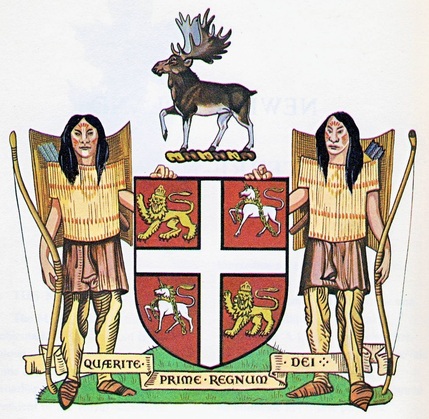Were the Arms of Newfoundland Granted to the Province Originally? / Les armoiries de Terre-Neuve étaient-elles originellement assignées à la province ?
Were the Arms of Newfoundland Granted to the Province Originally?
The biography of Sir David Kirke in the Dictionary of Canadian Biography contains the following statement: “The coat of arms granted to these Adventurers [the Company of Adventurers to Newfoundland] is that of the Province of Newfoundland today.” Various sites on the Internet claim that the grant of arms was in fact to Sir David Kirke. Fox-Davies sets the record straight in The Book of Public Arms (1915), p. 550: “This coat of arms has been generally attributed to the Newfoundland Company. The grant, however, was made to ‘the country’.” If we look at the actual letters patent of King Charles I dated the 1st of January 1637 and reproduced, for instance, in Beddoe’s Candian Heraldry, p. 77-78, the document clearly specifies twice that the arms are granted to the country, which is clearly identified as Newfoundland. Sir David Kirke is mentioned as one of the persons to whom the island was granted on 13 November 1637 and as a petitioner of arms for the newly acquired territory. But how could the grant of the island be made in November 1637 and the subsequent grant of arms in January of the same year? This is explained by the fact that until 1752, the new year started on March 25 in England. By today’s calendar, the year would be 1638.
The biography of Sir David Kirke in the Dictionary of Canadian Biography contains the following statement: “The coat of arms granted to these Adventurers [the Company of Adventurers to Newfoundland] is that of the Province of Newfoundland today.” Various sites on the Internet claim that the grant of arms was in fact to Sir David Kirke. Fox-Davies sets the record straight in The Book of Public Arms (1915), p. 550: “This coat of arms has been generally attributed to the Newfoundland Company. The grant, however, was made to ‘the country’.” If we look at the actual letters patent of King Charles I dated the 1st of January 1637 and reproduced, for instance, in Beddoe’s Candian Heraldry, p. 77-78, the document clearly specifies twice that the arms are granted to the country, which is clearly identified as Newfoundland. Sir David Kirke is mentioned as one of the persons to whom the island was granted on 13 November 1637 and as a petitioner of arms for the newly acquired territory. But how could the grant of the island be made in November 1637 and the subsequent grant of arms in January of the same year? This is explained by the fact that until 1752, the new year started on March 25 in England. By today’s calendar, the year would be 1638.
Les armoiries de Terre-Neuve étaient-elles originellement assignées à la province ?
La biographie de sir David Kirke dans le Dictionnaire biographique du Canada contient l’affirmation suivante : « Les armoiries accordées aux Adventurers [Company of Adventurers to Newfoundland] sont celles de la province de Terre-Neuve aujourd’hui ». La notion que ces armoiries étaient concédées en premier lieu à sir David Kirke est également répandue sur Internet. Dans son ouvrage The Book of Public Arms (1915), p. 550, Fox-Davies faisait une mise au point : « On a généralement attribué ces armoiries à la Newfoundland Company, mais elles étaient concédées au pays. » Pour en avoir le cœur net, il faut consulter les lettres patentes originales du roi Charles Ier datées du 1er janvier 1637 et reproduites, par exemple, dans Beddoe’s Candian Heraldry, p. 77-78. Ce document indique sans équivoque, et à deux reprises, que les armoiries sont assignées au pays, clairement identifié comme étant Terre-Neuve. Sir David Kirke est mentionné comme l’une des personnes à qui le roi avait concédé l’île le 13 novembre 1637 et aussi comme l’un des copropriétaires qui demandaient la concession d’armoiries au territoire nouvellement acquis. Mais comment la concession de l’île pouvait-elle avoir lieu le 13 novembre 1637 et la concession subséquente d’armoiries, en janvier de la même année ? Il faut comprendre que le nouvel an débutait le 25 mars en Angleterre jusqu’en 1752. Selon le calendrier actuel, l’année serait 1638.
